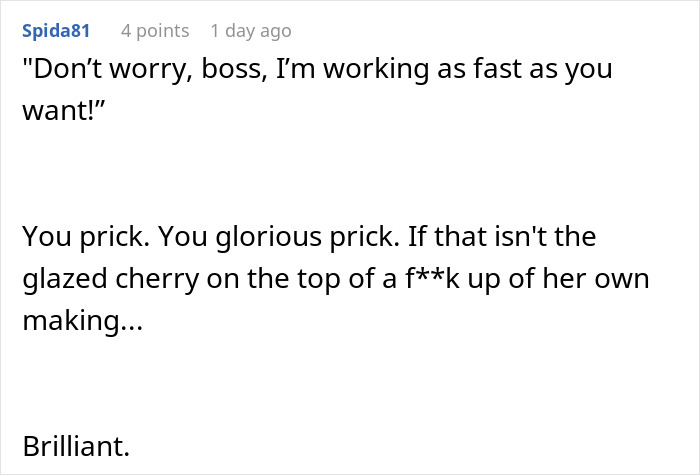Not only is the sheer number of people experiencing burnout higher than ever, but it is hitting workers at younger ages—and its effects are more debilitating.
The 2023 Stress in America survey shows that 67% of adults ages 18 to 34 feel like stress makes it difficult for them to focus, 58% describe their daily stress as “completely overwhelming,” and nearly half report that most days their stress is so bad they’re unable to function.
A recent story on the subreddit ‘Malicious Compliance‘ acts as a vivid illustration of these grim numbers. Shared by a worker who goes on the platform by the nickname 0x1337D00D, it describes what happens to the whole company when a manager is hell-bent on getting the most out of their employees, no matter the cost.
This person’s supervisor believed that speed and only speed was the key to their team’s success

Image credits: StockRocketStudio (not the actual photo)
So she sacrificed any and all quality—and it completely backfired







Image credits: DC_Studio (not the actual photo)







Image credits: YuriArcursPeopleimages (not the actual photo)




Image credits: 0x1337D00D
Too many employees are being pushed to and even past their breaking point
David Sluss, who is an associate professor of organizational behavior at Georgia Tech’s Scheller College of Business, says that organizations need to redefine the meaning of speed.
“The U.S. Navy SEALs are known for their saying ‘Slow is smooth, and smooth is fast.’ These rapid-response special forces teams are paradoxically methodical and patient in both planning and executing their time-critical missions,” Sluss writes.
Sluss explains that these highly effective professionals “have learned over 60 years of operating in crisis situations that working at a slow and smooth pace reduces mistakes and re-dos and in the end speeds up the mission.”
In short, they have learned that leaders shouldn’t “confuse operational speed (moving quickly) with strategic speed (reducing the time it takes to deliver value). And this of course means that leaders need to clearly define what delivering value means from the start.”
To learn more about patience at the workplace, he surveyed 578 full-time U.S. employees from a wide range of industries during the Covid-19 lockdown, when everyone was on high alert. Their average age was thirty-nine, most were college graduates, and more than half were in managerial roles themselves.
Sluss asked about their immediate supervisor’s leadership behaviors and level of patience and had them self-report their own levels of creativity, productivity, and collaboration. The responses revealed that patience had a powerful effect: when leaders demonstrated it (meaning their employees’ ratings put them in the highest quartile), people’s creativity and collaboration increased by an average of 16% and their productivity by 13%.
Sometimes, asking to slow down will get you more, and hopefully, the lady from our story will eventually understand this.

Image credits: Jonathan Borba (not the actual photo)
As the story went viral, it received a lot of colorful reactions























